| |
Observing
tips: Look
west 30 to 60 minutes after sunset when
the Sun has dipped 6o to 16o below the horizon.
If you see luminous blue-white tendrils spreading across the sky,
you've probably spotted a noctilucent
cloud. Although
noctilucent clouds appear most often at arctic latitudes, they have
been sighted in recent years
as far south as Colorado, Utah and possibly Virginia. NLCs are seasonal,
appearing most often in late spring and summer. In the northern
hemisphere, the best time to look would be between mid-May and the
end of August. See also 2003,
2004, 2005,
2006, 2007,
and 2008 |
 |
| |
| |
Photographer,
Location |
Images |
Comments |
|
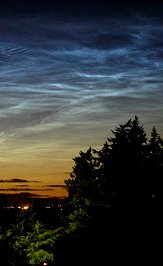
|
Mark Seibold,
Mount Tabor in Central Portland Oregon
Jul. 23, 2009 |
#1,
#2, more |
I ensconced
myself on top of Mount Tabor in central Portland Oregon
to render a pastel sketch of the two day old crescent moon
observed through a Nexstar 5i Cassegrain as one of my usual
works. As I was showing the public the moon setting onto
Portland's West Hills through the telescope, I noticed a
strange silver light in what appeared as the north-northwest
sky lighting up with I thought was aurora borealis. I then
realized that I was seeing the most amazing display of noctilucent
clouds that I had ever witnessed. Perhaps my first ever.
I had to drop the pastel chalks, grab the camera and take
a vantage point on the slopes of the west of Mt Tabor over
the large reservoir with the city skyline to the west. It
was at 10:15PM PDT, an hour and a half after sunset in dark
sky with only a hint of twilight glow at the horizons edge.
**The pastel artwork was inhibited by the photography but
should follow soon. |
|

|
Vince Varnas,
Portland, Oregon
Jul. 23, 2009 |
#1 |
For the third time this month, we had noctilucent clouds over Portland, Oregon. I photographed them from my roof top. They were brightest at 9:54 P.M. They started out as iridescent white around 9:40 P.M. and became iridescent blue at 9:54 P.M., when I took this photo. I used a Canon 5D Mark II with a Canon EF 17-40mm, f/4L lens at about 30mm setting. I set my camera at 400 ISO and center-weighted the meter for a 1.5 sec. exposure and at f/4
|
|
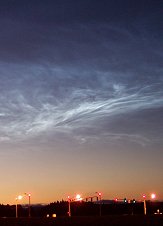
|
Benjamin Monjay,
Hillsboro, Oregon, USA
Jul. 23, 2009 |
#1,
#2,
#3 |
The best display of NLC's that I have ever seen! I took these at the North end of the Hillsboro Airport, Oregon (KHIO).
|
|
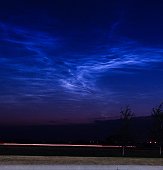
|
Brian Chilcoat,
Spokane, Washington, USA
Jul. 23, 2009 |
#1 |
Captured with Sony DSC-W170, ISO 100, f/4.0 2"
|
|
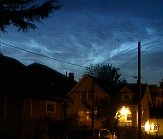
|
Paul Wagner,
Portland, Oregon, USA.
Jul. 23, 2009 |
#1,
#2 |
We stepped out to catch the ISS/Shuttle flyover, but that performance was outstaged by one of the most spectacular NLC displays I've ever witnessed!
Photo details: Casio Exilim, 6MP, night mode.
|
|
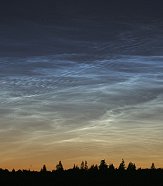
|
Andrew Robb,
Beaverton Oregon USA
Jul. 23, 2009 |
#1,
#2, #3,
#4 |
They're back! NLC's are back over Oregon in full force. They came through like a storm, they were the brightest I've seen yet over the Portland area, and they really had a nice variety of forms. What a Sight!
Canon EOS 30" exposure
|
more
images: from
Andrew Nawrot of Portland, Oregon; from
Verene Lystad of Seattle, Washington; from
Ray Gilmore of Gig Harbor Washington; from
Austin James of Redmond, Oregon; from
Linda Neilsen of Seattle area, Washington
|
|
|







